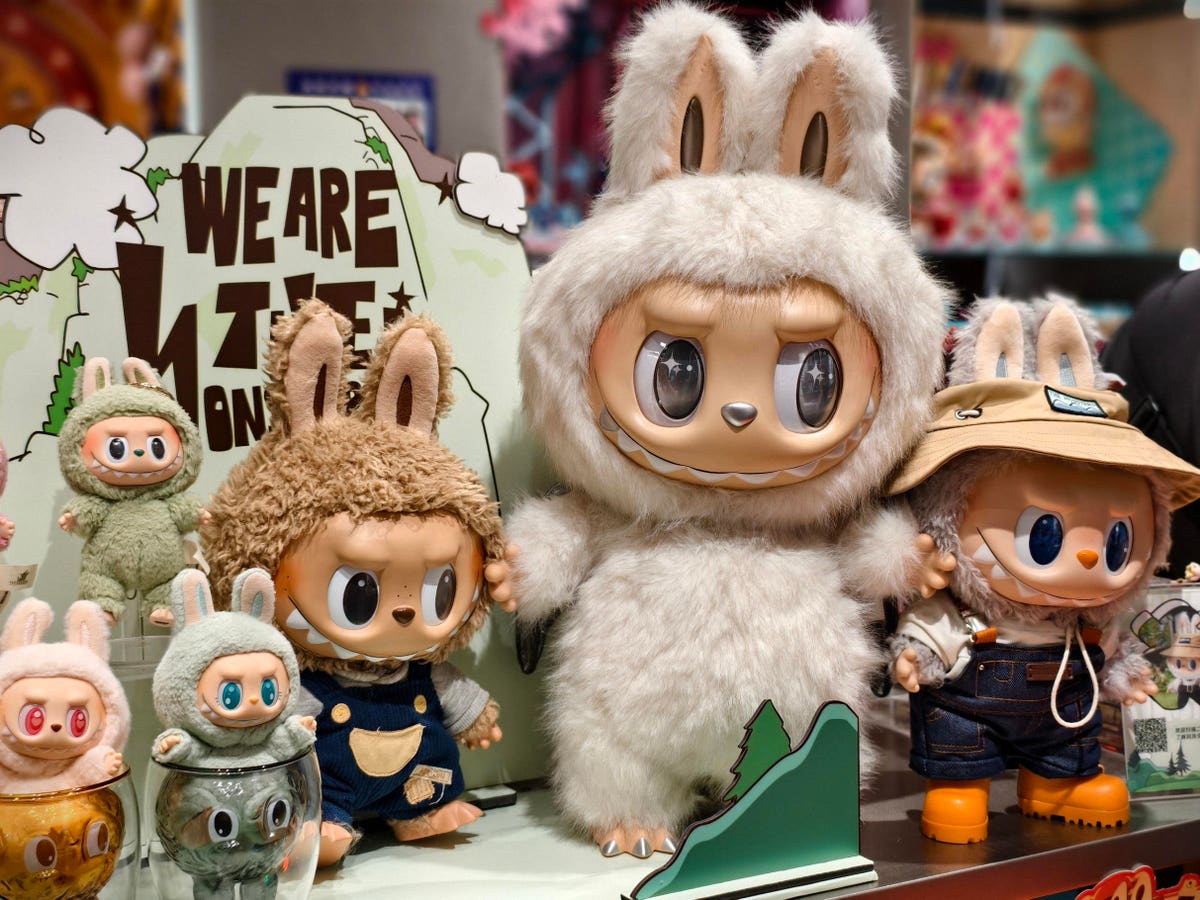GUANGZHOU, CHINA – JUNE 10: Labubu dolls are on sale at a Pop Mart store on June 10, 2025 in … More
In an era of rising geopolitical friction, the global creator community thrives in a borderless realm. While governments debate bans and erect digital barriers, creators move fluidly across platforms, cultures, and tools—guided by creativity rather than nationality. This ethos often transcends the constraints that hobble traditional industries.
Even as Washington scrutinizes Chinese-owned apps, American creators are enthusiastically embracing Chinese cultural exports and innovations. For example, Labubu—a mischievous vinyl art toy born in China—has become a cult hit among Western collectors, and Hunyuan 3D—a cutting-edge AI model—enables creators to generate 3D content from simple text prompts. Together, they illustrate how the grassroots creator economy operates as a truly global village, with trends and technologies flowing across borders.
Unlike traditional companies anchored by national regulations and physical supply chains, creators operate in a decentralized, borderless marketplace of ideas. They owe no allegiance to any particular country or corporate HQ—only to the platforms and trends that best amplify their voices. It’s globalization from the ground up, driven not by trade agreements or corporate mergers but by memes, viral challenges, and collaborative culture. In this creator-driven ecosystem, cross-cultural exchange isn’t the exception; it’s the rule.
Cultural Currents: America’s Undiminished Embrace of Chinese Pop Culture
Pop Mart’s Labubu art toys on display; this Chinese designer figure has become a cultural crossover hit among collectors worldwide. Even amid geopolitical strains, Chinese pop culture continues to captivate Americans in unexpected ways — exemplified by Labubu, a mischievous vinyl art toy from China that has become a cult sensation among Western collectors. American fans draw Labubu fan art, binge on unboxing videos, and remix the character through digital memes. This is more than a niche fad; it reflects a genuine enthusiasm for Chinese aesthetics and storytelling breaking into the U.S. mainstream.
The Labubu phenomenon underscores how cultural trends can transcend borders organically. Its Western rise wasn’t orchestrated by any official campaign; instead, it spread via TikTok clips, collector communities, and even celebrity buzz. Riding this momentum, Beijing-based Pop Mart reported nearly 40% year-on-year revenue growth and now boasts a market value approaching $6 billion—a testament to the global appetite for its collectibles. Ultimately, Labubu’s journey exemplifies how naturally these cross-cultural currents flow: not through top-down agendas but through viral content and grassroots fandom. In a digital era where a cute character born in Beijing can enchant audiences in Los Angeles, the origin of a trend matters far less than the connection it makes.
The Tech Beneath the Trends: Bridging the Divide with AI
When it comes to creative tools, origin matters less than output. In AI, for instance, cutting-edge models can now generate a polished video clip from a single written prompt—capabilities once reserved for Hollywood studios. And it’s not only American labs pushing the envelope. Hunyuan 3D, for example, produces high-quality 3D models from mere text or image inputs, drastically lowering the skill and cost barrier for 3D content creation. A solo creator can tackle projects that once required an entire art department. American artists have begun experimenting with Hunyuan 3D for everything from character designs to digital collectibles; some even use it to craft Labubu-inspired 3D avatars, bringing that toy icon into the virtual realm. What was a complex task yesterday is becoming plug-and-play today.
Navigating the Storm: The TikTok Dilemma and Creative Resilience
In the U.S., a recurring debate over TikTok’s Chinese ownership and national-security risks has cast uncertainty over the platform’s future. At one point, officials even attempted to force TikTok’s parent, ByteDance, to sell its U.S. operations under threat of a ban—underscoring how precarious a creator’s dependence on one app can be. For many influencers, especially Gen Z stars who built their brand and business on TikTok, such threats feel existential.
Yet rather than panic, creators have been quick to adapt. Many are hedging their bets by diversifying to other channels—spreading their content to Instagram, YouTube, or any emerging platform that might capture the TikTok vibe. Intriguingly, some are even exploring Chinese-born alternatives. A small but growing number of American creators, for instance, have tried Xiaohongshu (“RedNote”), a popular Chinese social app known for its highly engaged communities and glossy aesthetic.
This trend reveals a paradox: even as policymakers talk about severing digital ties, creators are busy forging new ones. Their choices are guided far less by geopolitics than by creative opportunity and audience reach. If a platform offers a passionate user base or unique format, they will give it a go—no matter where it was built or who owns it.
Creators Lead, Businesses Follow: A New Global Blueprint
The agility of creators offers a lesson for traditional enterprises. Where a big company might hesitate to use a foreign-made app—held back by compliance reviews or PR worries—an independent creator will grab any tool that gives a creative edge. They experiment in real time, guided by immediate audience feedback rather than corporate policy. This freeform approach is charting a new blueprint for global engagement that forward-looking businesses would be wise to note.
Indeed, attempts to erect digital walls or ban popular tools may slow the flow temporarily, but the underlying demand for connection and creativity inevitably finds a detour. While political and corporate leaders wrangle over the rules, creators are already operating in a borderless digital sphere where ideas and collaborations circulate freely. Companies that tune into these grassroots currents can uncover new opportunities—and avoid blind spots—in a market that is increasingly global by default.
The Resilient Threads of Global Creativity
Geopolitical winds may shift, but the bonds of creativity remain resilient. American creators continue to draw deeply from Chinese pop culture and technology—not out of political alignment, but out of creative curiosity and necessity. Apps and platforms may rise or fall, yet the urge to share stories and innovate transcends any single medium or border.
In truth, creators aren’t just reacting to global change; they’re shaping it. In their hands, digital tools become bridges rather than barriers. A vinyl toy born in Beijing can inspire a 3D avatar in Los Angeles; a Chinese AI model can help spark the latest viral dance craze in New York. Even if TikTok disappears tomorrow, a young vlogger will simply pivot to another outlet like Xiaohongshu to keep creating. Each of these acts is a thread in a quiet, bottom-up globalization tapestry. And no matter what obstacles arise, creators will keep weaving those global threads—driven by the timeless human drive to imagine and connect.









